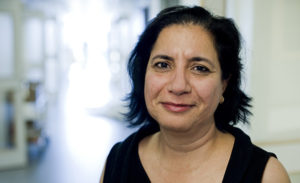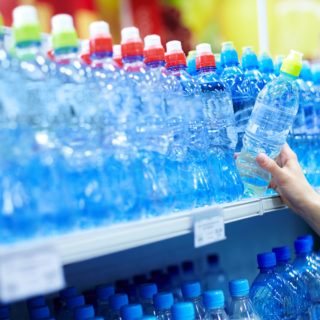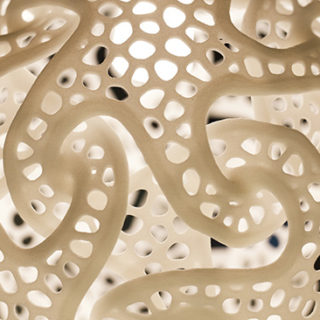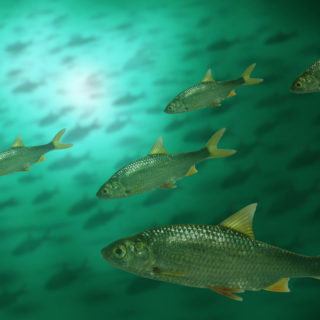Searching for eco-friendly, sustainable plastic
Plastic is a versatile material that we want to continue to use, but the plastic production and pollution of today leads to sustainability and environmental problems. Researchers within the STEPS programme at Lund University envision a future society in which plastics are produced, used and recycled in a sustainable way in a circular economy.
Plastic is an artificial material, made from small building blocks that generally come from fossil oil. At Lund University, researchers want to create new, sustainable plastics from largely renewable raw materials and give them enhanced properties. The selection of the building blocks, the way they are assembled into long so-called polymers, and the additives used determine the properties of the plastic.
One step at a time
Which renewable raw materials available in Sweden are the most appropriate? How do we design processes to manufacture building blocks in an environmentally friendly and resource-efficient way? What should the composition of the building blocks be like to give the plastic enhanced or entirely new properties? These questions are currently discussed by the researchers involved in the STEPS programme. However, the focus is not only on the challenges of bioengineering and chemistry; it is also crucial to discuss, in collaboration with industry and product users, what is technically, financially and socially feasible today. It is also important to take things one step at a time…
“On the programme, we focus on a group of polyester plastics with multiple areas of application, such as packaging, textiles, films, etc. We will start by producing ‘classic’ models of building blocks from renewable raw materials, then convert these into polyester with the same structure and properties already used in the industry, to develop new plastic fibres, sheets and coatings that can quickly be applied to current production”, says Rajni Hatti-Kaul, bioengineer and head of the STEPS programme.
The road ahead….
Rajni Hatti-Kaul and her colleagues in biotechnology and chemical engineering are investigating how to produce both old and new types of building blocks from renewable raw materials. The raw materials that are about to be tested include sugar from sugar beets and by-products from sugar mills, starch from potato farming, and cellulose from forestry and agricultural by-products. “In a year or so, we also want to begin designing processes to convert carbon dioxide into chemicals”, says Rajni Hatti-Kaul. “The advantage of carbon dioxide is that it allows us to utilise present greenhouse gas and avoid land appropriations for the production of biomass”.

Professor Rajni Hatti-Kaul Photo: Kennet Ruona
New plastics with new properties
The chemists and polymer engineers at the Centre for Analysis and Synthesis are responsible for assembling the building blocks needed to create polymer. The challenge for them is to figure out the best possible way to convert the new building blocks into biopolymers with the same or enhanced properties in terms of sustainability, flexibility, mechanical and thermal stability, and biodegradability. In these processes, the researchers also strive to minimise the use of toxic additives. Several research groups at the Lund University Faculty of Engineering (LTH), the Swedish University of Agricultural Sciences (SLU), and the Swedish Research Institute for Industrial Renewal and Sustainable Growth (Swerea IVF) will contribute to the characterisation and evaluation of plastic products.
“We will start by trying to find new polymers for packaging materials, bottles, textiles and different coating materials”, says Baozhong Zhang, polymer engineer and one of the people in charge of the project within STEPS. “We have to keep in mind that the sustainable plastics must be reusable or recyclable, that is, they are to be designed so that they can be reused multiple times, or possibly broken down into their respective components and then re-developed into plastic. For example, we want to create non-toxic plastics that can be composted so that the chemical components once again become part of the cycles of nature”.
The researchers also want to produce plastics with completely new properties. Baozhong Zhang is eager to develop new biopolyesters with tailored properties for specific applications. It could be anything from plastics that are electrically conductive, or ones that can endure very high temperatures. Other types of plastic that are in demand are those that have light, strong, and durable constructions, and can be used to make cars, airplanes or food containers which would require less energy-consuming transports.
“People sometimes think that certain things cannot be made from plastic. But through our approach, we hope to develop some new techniques and new materials, so that plastic can be used in completely new contexts”, says Baozhong Zhang.
The STEPS research programme includes a large group of researchers and stakeholders who are collectively trying to find the answers to what information is needed in order to change regulations and policies to create an environmentally sustainable cycle of plastic in Sweden.
Text: Pia Romare
Facts
-
Plastic
-
All plastic is made out of small carbon molecules – monomers – which can be seen as a type of chemical building blocks. The monomers are assembled into polymers: large chain-shaped unbranched or branched molecules, through a chemical process called polymerisation.
The selection of the building blocks, the way they are assembled into polymers, and the additives used determine the properties of the plastic material, that is, how it is affected by heat or cold, whether it’s hard or soft, transparent or opaque.
Plastic can be found everywhere in our society. We use plastic bags, plastic packaging, PET bottles, fleece textiles, and household products and construction materials made out of plastic. Today, plastic has become a major problem; partly because most plastics are produced from fossil oil or coal, resulting in carbon dioxide emissions which contribute to global warming. Furthermore, the additives used are often toxic. Most plastics take a long time to decompose and a lot of plastic remains in nature – both in in the form of visible plastic debris and nanosized plastic particles. In both cases, they can harm wildlife.
Within STEPS, the focus is on producing bio-based polyester. Polyester is a polymer that contains ester groups. There are various types of polyester; they are part of, for instance, plastics, fibres and paint. Some types of polyester are used as PET and synthetic fibres; others are used as construction plastics or as raw materials for reinforced glass fibre ester plastic. Source: (in Swedish) Nationalencyklopedin, polyester, http://www.ne.se/uppslagsverk/encyklopedi/lång/polyester (retrieved 6 September 2016)
-
STEPS
-
The newly established research group STEPS research programme (Sustainable Plastics and Transition Pathways) has as its goal to help speed up society’s adjustment to a sustainable production and use of plastic. Therefore, over the next four years the researchers will work within three different areas to
- develop the production of new versatile building blocks for plastic from renewable raw materials, to replace fossil fuels and avoid toxic additives,
- develop new plastics with desired properties that are also recyclable,
- analyse potential ways of societal adjustments to provide a basis for policy and industry strategies for long-term sustainability.
STEPS combines research in several different areas at Lund University: chemistry, chemical engineering, bioengineering, polymer engineering and processes, product development, energy and environmental systems analysis, innovation studies, sociology and political science. Within STEPS, the researchers also work closely with raw materials companies (e.g. Nordic Sugar, Lyckeby, Södra), chemicals and plastics producers (Perstorp, SEKAB) and users (e.g.. IKEA, Region Skåne, Bona) on issues concerning which building blocks to invest in, how to expand the processes into industry production, and what new properties or plastic products are in demand, as well as waste management and recycling companies (e.g. Sysav, Hans Andersson Plastics and Miljösäck).
Rajni Hatti-Kaul at the Department of Biotechnology is head of the programme and in charge of the first research area. The other two research areas are led by Baozhong Zhang at the Centre for Analysis and Synthesis, and Lars J. Nilsson at the Division of Environmental and Energy System Studies.






